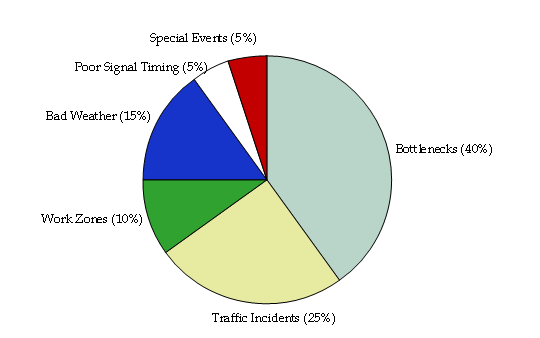While the United States has seen remarkable improvements in freight transportation since the 1980s, congestion threatens to increase travel times, drive up logistics costs, and undermine the reliability of freight shipments. The problem of congestion is especially acute for trucking.
One measure of the performance of the nation's freight transportation system is total logistics cost. Total logistics cost is the cost of managing, moving, and storing goods. The major components of total logistics cost are administration (e.g., management, insurance), transportation (e.g., by truck, rail, air, and water), and inventory carrying costs. Figure 2.1 shows total logistics cost as a percentage of the U.S. gross domestic product (GDP). Logistics costs rose through the 1960s and 1970s to a high of about 16 percent in 1980, then declined through the 1980s and 1990s. Total logistics costs today are estimated to be about eight percent of GDP.
A major factor in the decline in total logistics cost has been lower truck, rail, air, and water freight transportation costs.1 Freight transportation costs are lower because:
Figure 2.1 Total Logistics Cost as Percentage of U.S. Gross Domestic Product
Cost Trend
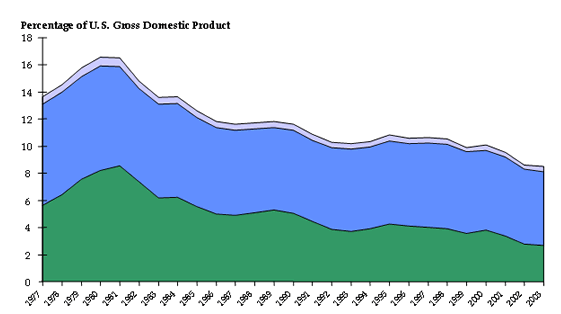
Shippers have taken advantage of the lower transportation costs to buy more frequent, more reliable, and more long-distance freight transportation. They have done so for a number of reasons, including:
These changes have hastened a broad shift in business logistics practices from manufacture-to-supply or inventory-based logistics ("push logistics") to manufacture-to-order or replenishment-based logistics ("pull logistics"). "Push logistics" relies on careful maintenance of large inventories—between parts suppliers and manufacturers, between manufacturers and wholesalers, and between wholesalers and retailers—to buffer the bullwhip effect of unanticipated surges in supply and demand and guard against stock-outs along the supply chain. "Pull logistics" relies less on expensive inventory and more on accurate information and timely transportation to match supply and demand and prevent stock-outs. Better coordinated "pull logistics" is the underpinning of just-in-time manufacturing and just-in-time retailing.
"Pull logistics" has produced a tightly integrated and very efficient freight transportation network, generating enormous savings for U.S. businesses, expanding the choice of goods and services available to consumers, and allowing U.S. manufacturers to compete effectively in global markets. However, these benefits have come at a cost. The freight transportation network today is tightly strung and very sensitive to disruption. Congestion threatens to disrupt this freight network, increasing travel times, undermining reliability, and driving up transportation costs.
The extent of congestion today can been seen in the map in Figure 2.2, which shows congested roadways in 19982. Congestion is calculated by comparing roadway capacity to average annual daily traffic (AADT) volumes as reported in the FHWA Highway Performance Monitoring System (HPMS). When traffic volume approaches 90 to 95 percent of capacity, highways become intensely congested. Highway segments shown in red in the figure are exceeding capacity, while highway segments in yellow are approaching capacity.3 The congestion is reported only for roadways in the National Highway System and reflect average conditions. Actual congestion levels vary substantially by hour, day, and week.
Congestion means longer travel times, increased costs, and less reliable pick-up and delivery times for truck operators. To compensate, motor carriers typically add vehicles and drivers and extend their hours of operation. Over time, most of these costs are passed along to shippers and consumers. The Federal Highway Administration (FHWA) estimates that increases in travel time cost shippers and carriers an additional $25 to $200 per hour depending on the product carried. The cost of unexpected truck delays can add another 50 percent to 250 percent.4
Figure 2.2 Congested Highways
1998
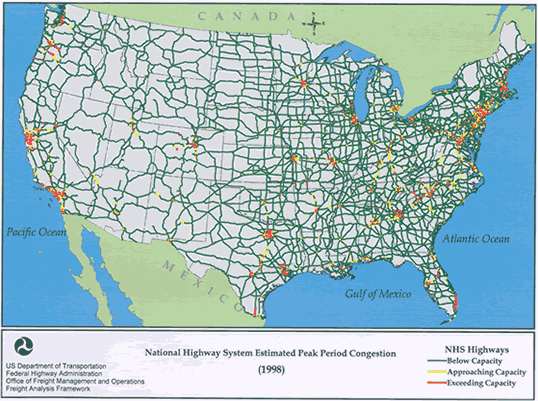
No statistics describe the cost of congestion to the nation's freight transportation system as a whole. However, data from the Texas Transportation Institute's "Annual Mobility Reports" show large and steady increases over the last 20 years in the cost of congestion to automobile and truck drivers in the nation's metropolitan areas. Figure 2.3 shows the estimated annual congestion costs in 85 small, medium, and large urban areas from 1982 to 2002, with the annual cost approaching $63 billion in 2002.5
Figure 2.3 Annual Congestion Costs
85 Metropolitan Areas
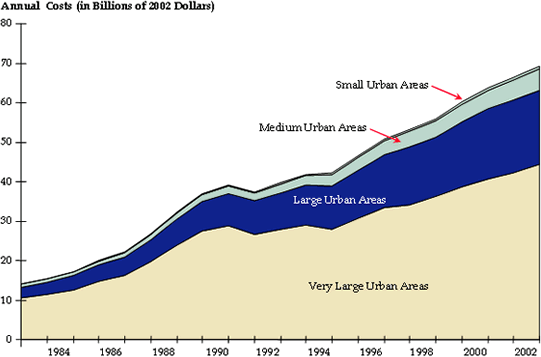
The increase in congestion and congestion costs reflects the fact that over the last 20 years vehicle miles of travel (VMT) on U.S. roads have nearly doubled while lane miles have increased only about four percent. Figure 2.4 compares the growth in VMT to the growth in lane miles.6 The index year is 1980.
Figure 2.4 Vehicle Miles of Travel and Roadway Lane Miles
Growth Index, 1980 to 2002
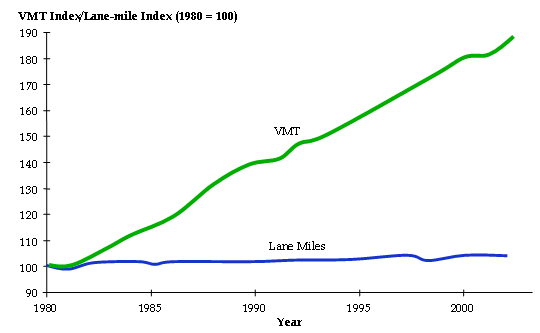
It is unlikely that highway capacity will expand rapidly in the coming decades. The FHWA, in its Condition and Performance Report to Congress, and the American Association of State Highway and Transportation Officials (AASHTO), in its Bottom Line Report, estimate the levels of future capital expenditures needed to maintain and improve the performance of the nation's highway system. Figure 2.5 compares the four estimates of annual highway needs—including operations and maintenance costs—to the forecast of annual highway revenues for the period 2000 to 2025.7 Current annual revenues will suffice only to maintain the highway system, not provide significant new capacity.
Figure 2.5 Annual Highway Needs Compared to Annual Highway Revenues,
2000-2025, Base Case Forecasts
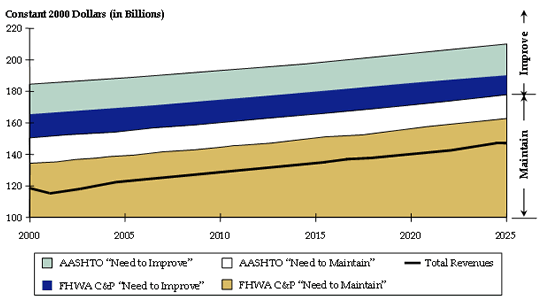
Without significant improvements in capacity or throughput, congestion on the nation's highways will increase, driven by population growth, economic development, and the resulting demand for freight transportation. Between 1998 and 2020, total VMT is projected to increase at a rate averaging about 2.5 percent annually with truck VMT rising faster that automobile VMT.8 Figure 2.6 shows potentially congested highways in 2020. Again, the map shows average conditions, but suggests clearly that today's metropolitan congestion may extend well into intercity highway freight corridors by 2020.
Figure 2.6 Potentially Congested Highways
2020
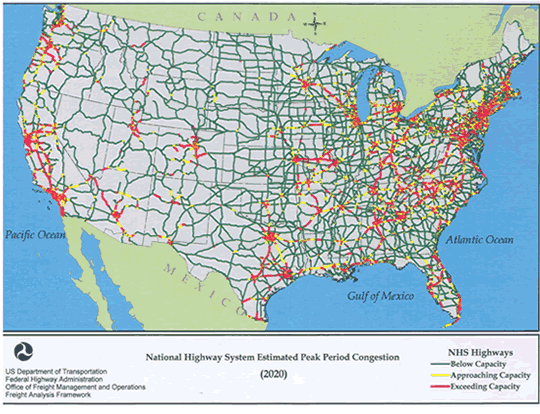
Trucking is heavily exposed to congestion because it is the dominant freight transportation mode. According to the 2002 Commodity Flow Survey, trucks carried 67 percent of domestic shipments by tons, 74 percent by value, and 40 percent by ton-miles. Figure 2.7 shows the breakdown of freight shipments by mode in tons, value, and ton-miles.9
Figure 2.7 Freight Tons, Value, and Ton-Miles by Mode
2002
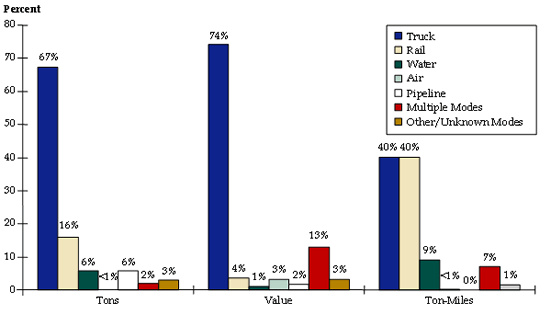
Trucking is the dominant mode today because it provides fast, reliable, and competitively priced freight transportation service that can be tailored to the needs of shippers and receivers. The demand for trucking, and the number of trucking companies, has grown in step with the economy. The number of interstate motor carriers increased from 18,000 in 1975 to over 500,000 in 2000.10
The cost and productivity of trucking depend in part on the condition and performance of the National Highway System. Figure 2.8 shows the density of truck freight shipments along major highway corridors; the wider the line representing the roadway, the more truck freight tonnage carried on that route.11
Figure 2.8 Average Annual Daily Truck Traffic
1998
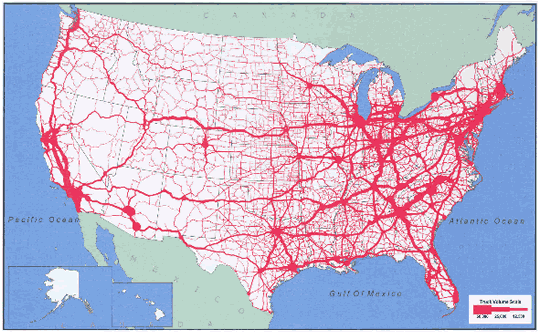
Trucking will be more exposed to congestion in the future. The FHWA projects that between 1998 and 2020 domestic freight volumes will grow by more than 65 percent, increasing from 13.5 billion tons to 22.5 billion tons.12 Trucks are expected to move over 75 percent more tons in 2020, capturing a somewhat larger share of total freight tonnage than currently. To carry this freight, truck VMT is expected to grow at a rate of more than three percent annually over the same period.
Without major capacity investments, the FHWA estimates that by 2020, 29 percent of urban National Highway System routes will be congested or exceed capacity for much of the day and 42 percent of National Highway System routes will be congested during peak periods. By comparison, only 10 percent of the urban National Highway System routes were congested in 1998.
Urban Interstate highways, the portion of the National Highway System that carries the most freight trucks, are and will continue to be the most traveled segments. The FHWA estimates that the percentage of urban Interstate sections carrying more than 10,000 trucks per day will increase from 27 percent in 1998 to 69 percent in 2020.13 Approximately 53 percent of urban Interstate mileage will be congested in 2020 as compared to about 20 percent today.
These statistics suggest that, as congestion increases in the coming decades, the speed and reliability of truck freight transportation will deteriorate and costs to shippers and receivers may rise.
Other freight transportation modes will carry more freight as the economy grows, but they will complement, not replace, truck freight transportation.
The volume of cargo by air is growing rapidly, but air cargo is limited to lighter, high-value shipments and is only economical over longer distances.
The water transportation system, including coastal and inland-waterway barge service, is critically important for the transportation of heavy, bulky grains, clays, gravels, etc., but water transportation services are restricted to coastal areas and major waterways. The Maritime Administration is working with several states and carriers to explore expanded short-sea shipping services for truck trailers and intermodal containers (e.g., for moves between major international gateways and regional ports), but the provisions of the Jones Act, which restricts most U.S. coastal shipping business to U.S. flag carriers, make rapid expansion of short-sea shipping services unlikely.
The railroads are expanding intermodal freight service, carrying more trailers and domestic and international containers for motor carriers on long-haul moves. Motor carriers such as United Parcel Service are among the railroads' largest customers today. Rail intermodal traffic has been growing steadily and is now the largest source of revenue (although not the most profitable source) for several railroads. However, the railroads' capacity to expand intermodal service quickly while maintaining carload and unit train (bulk) service is limited.
Federal government rescinded economic regulation of the freight railroads in 1980. The railroads responded by reorganizing and downsizing to match the shrinking demand for freight-rail services in the 1980s. However, economic growth over the last decade has absorbed much of the underutilized capacity of the railroads' deregulated and downsized system, and congestion is now increasing at major network choke points. The major freight-rail gateways and corridors thought to be most at risk because of congestion are:
New freight-rail capacity is needed to keep pace with the expected growth in the economy and relieve congestion at these major network choke points, but creating this capacity will be a challenge for the railroads. The railroad industry today is stable, productive and competitive, with enough business and profit to operate, but it does not have the resources to replenish its infrastructure quickly or grow rapidly. Productivity and volume have gone up since deregulation of the railroads in 1980, and prices have gone down. But competitive pricing has forced rail revenues down.14
AASHTO, in its Freight-Rail Bottom Line Report, estimated that the railroads must invest $175 to $195 billion over the next 20 years to address the worst bottlenecks and keep pace with the growth of the economy.15 AASHTO estimated that the freight railroads are capable of funding about $142 billion of that program, leaving a budget shortfall of up to $53 billion (or $2.65 billion annually). The recent surge in rail demand has made it possible for the railroads to raise their rates and increase earnings and profits, but industry observers do not expect revenues to increase sufficiently to close the longer-term funding gap and ensure that the railroads can keep up with the demand generated by economic growth.
If the freight railroads cannot maintain their current share of national freight, then some rail freight will be shed to trucks on an already congested highway system. This will impose greater costs on state and local highway agencies, which must maintain roads; on highway users, who will experience increasingly congested roads; and on shippers, who will pay higher rates for truck service than they did for rail service.
In an environment of diminishing returns from investments in the Interstate highway system and deregulation of the freight transportation industry, growing highway congestion threatening to undermine trucking productivity, and limitations on the railroad industry's capacity to expand quickly, it is important to look closely at strategies to attack congestion by reclaiming capacity from the existing highway freight system.
As illustrated in Figure 2.9, about 40 percent of the congestion is estimated to be caused by bottlenecks—recurring congestion at locations where the volume of traffic routinely exceeds the capacity of the roadway, resulting in stop-and-go traffic flow and long backups.16 The balance, about 60 percent of delay, is estimated to be caused by non-recurring congestion, the result of transitory events such as construction work zones, crashes, breakdowns, extreme weather conditions, and suboptimal traffic controls.17
This paper focuses on bottlenecks that create recurring congestion. State DOTs and metropolitan planning organizations have identified many of these bottlenecks. The American Highway Users Alliance released a report in 2004 that identified and compared the worst bottlenecks nationally.18 However, these studies have not looked specifically at how highway bottlenecks affect truck traffic.
The objective of this white paper is to take an initial and comprehensive look at highway truck bottlenecks to answer questions about how many there are, where they are, how many truck hours of delay they cause, and whether they affect long- or short-distance truck trips. This information will help the FHWA consider and shape policies and programs to minimize the delays caused by highway truck bottlenecks.
Figure 2.9 Sources of Congestion
